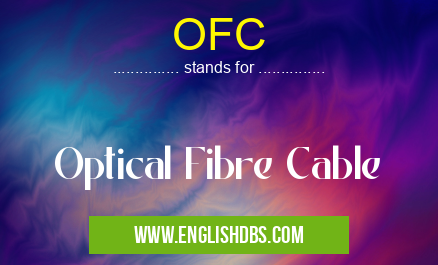What does OFC mean in OPTICS
OFC stands for Optical Fibre Cable. It is a type of cable that uses optical fibers to transmit light signals over long distances. Optical fibers are thin, flexible strands of glass or plastic that are capable of transmitting light over long distances with minimal loss of signal.

OFC meaning in Optics in Academic & Science
OFC mostly used in an acronym Optics in Category Academic & Science that means Optical Fibre Cable
Shorthand: OFC,
Full Form: Optical Fibre Cable
For more information of "Optical Fibre Cable", see the section below.
How OFC Works
OFC works by transmitting light signals through the optical fibers. The light signals are generated by a laser or LED at one end of the cable and are transmitted through the fibers to a receiver at the other end. The light signals are transmitted through the fibers by means of total internal reflection. This is a phenomenon that occurs when light strikes the boundary between two materials with different refractive indices at an angle greater than the critical angle. When this happens, the light is reflected back into the first material, rather than being transmitted into the second material.
Advantages of OFC
OFC offers a number of advantages over traditional copper cables, including:
- Higher bandwidth: OFC can transmit much more data than copper cables, making it ideal for high-speed applications such as broadband internet and telecommunications.
- Lower loss: OFC has a much lower signal loss than copper cables, which makes it possible to transmit signals over longer distances without the need for repeaters.
- Smaller size and weight: OFC is much smaller and lighter than copper cables, making it easier to install and maintain.
- EMI immunity: OFC is immune to electromagnetic interference (EMI), which makes it ideal for use in environments where there is a lot of electrical noise.
Applications of OFC
OFC is used in a wide variety of applications, including:
- Telecommunications: OFC is used to transmit voice, data, and video signals over long distances.
- Broadband internet: OFC is used to provide high-speed internet access to homes and businesses.
- Cable television: OFC is used to deliver cable television signals to homes and businesses.
- Medical imaging: OFC is used to transmit medical images, such as X-rays and MRI scans, from one location to another.
- Industrial automation: OFC is used to control and monitor industrial processes.
Essential Questions and Answers on Optical Fibre Cable in "SCIENCE»OPTICS"
What is Optical Fibre Cable (OFC)?
OFC is a type of telecommunication cable that uses light pulses to transmit data. It consists of thin, flexible fibres made of glass or plastic that are bundled together inside a protective sheath. OFC is widely used in high-speed data networks, telecommunications, and broadband internet connections.
How does OFC work?
OFC transmits data by guiding light pulses through its fibres. The light is modulated to carry the data, and it propagates through the fibres by a process called total internal reflection. This allows for high-speed data transmission over long distances with minimal signal loss.
What are the advantages of OFC over copper cables?
OFC offers several advantages over copper cables, including:
- Higher bandwidth: OFC can transmit much more data than copper cables, allowing for faster internet speeds and more efficient data transfer.
- Lower loss: OFC experiences less signal loss over long distances, resulting in better signal quality and longer transmission ranges.
- Electromagnetic interference immunity: OFC is not affected by electromagnetic interference (EMI), making it ideal for use in electrically noisy environments.
What are the different types of OFC?
There are several types of OFC, each designed for specific applications. Common types include:
- Single-mode fibre: Used for long-distance, high-bandwidth applications such as telecommunications and broadband internet.
- Multi-mode fibre: Used for shorter distances and lower bandwidth applications such as data centres and LANs.
- Plastic optical fibre (POF): A less expensive alternative to glass OFC, used for short-distance applications such as home networking and data cabling.
How is OFC installed and maintained?
OFC installation requires specialized equipment and expertise. It involves pulling the cables through conduits, splicing them together to create a continuous path, and terminating them at connection points. Regular maintenance is crucial to ensure optimal performance and longevity, including cleaning connectors and testing for signal loss.
Final Words: OFC is a versatile and reliable technology that is used in a wide variety of applications. Its high bandwidth, low loss, and immunity to EMI make it an ideal choice for high-speed data transmission over long distances.
OFC also stands for: |
|
| All stands for OFC |
